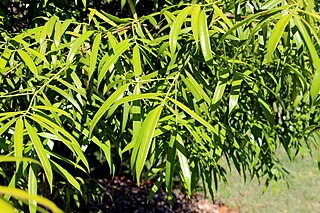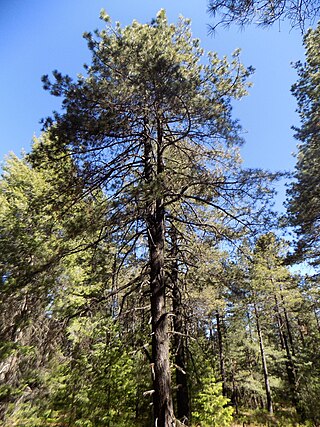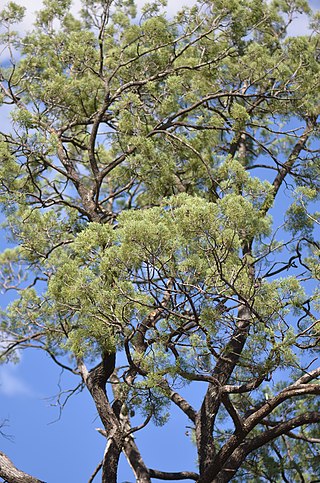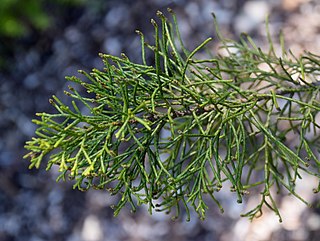Cypress is a common name for various coniferous trees or shrubs of northern temperate regions that belong to the family Cupressaceae. The word cypress is derived from Old French cipres, which was imported from Latin cypressus, the latinisation of the Greek κυπάρισσος (kyparissos). Cypress trees are a large classification of conifers, encompassing the trees and shrubs from the cypress family (Cupressaceae) and many others with the word cypress in their common name. Many cypress trees have needle-like, evergreen foliage and acorn-like seed cones.

Prumnopitys taxifolia, the mataī or black pine, is an endemic New Zealand coniferous tree that grows on the North Island and South Island. It also occurs on Stewart Island/Rakiura but is uncommon there.

Pinus serotina, the pond pine, marsh pine or pocosin pine, is a pine tree found along the Southeastern portion of the Atlantic coastal plain of the United States, from southern New Jersey south to Florida and west to southern Alabama. This pine often has a crooked growth pattern and an irregular top and grows up to 21 metres (69 ft) high, rarely to 29 metres (95 ft).

Pinus glabra, the spruce pine, is a tree found on the coastal plains of the southern United States, from southern South Carolina south to northern Florida and west to southern Louisiana.

Pinus arizonica, commonly known as the Arizona pine, is a medium-sized pine in northern Mexico, southeast Arizona, southwest New Mexico, and western Texas in the United States. It is a tree growing to 25–35 m tall, with a trunk diameter of up to 1.2 m. The needles are in bundles of 3, 4, or 5, with 5-needle fascicles being the most prevalent. This variability may be a sign of hybridization with the closely related ponderosa pine. The cones are single, paired, or in whorls of three, and 5–11 cm long.

Sundacarpus is a monotypic genus of conifers containing a single species Sundacarpus amarus, belonging to the family Podocarpaceae. Sundacarpus was designated a genus by C.N.Page in 1989; formerly it had been classified variously as a species of Podocarpus or of Prumnopitys.

Podocarpus lawrencei is a species of podocarp native throughout the Australian high country, from southern Tasmania through to the New South Wales highlands. Common names are Errinundra plum-pine and mountain plum-pine. It grows on exposed sites to 1,800 m, often forming living carpets over rocks through wind pruning.

Pinus durangensis, the Durango pine, is a pine tree species endemic to the Sierra Madre Occidental mountain range of north-western Mexico.

Callitris columellaris is a species of coniferous tree in the family Cupressaceae, native to most of Australia. Common names include white cypress, white cypress-pine, Murray River cypress-pine, and northern cypress-pine. Callitris columellaris has become naturalised in Hawaii and in southern Florida.

Pinus cubensis, or Cuban pine, is a pine endemic to the eastern highlands of the island of Cuba, inhabiting both the Sierra Nipe-Cristal and Sierra Maestra mountain ranges.

Pinus tropicalis, the tropical pine, is a pine tree endemic to the western highlands of the island of Cuba.

The Caribbean pine is a hard pine species native to Central America and the northern West Indies. It belongs to subsection Australes in subgenus Pinus. It inhabits tropical and subtropical coniferous forests such as Bahamian pineyards, in both lowland savannas and montane forests.
Actinostrobus acuminatus, commonly known as dwarf cypress, creeping pine or Moore cypress pine, is a species of coniferous tree in the Cupressaceae. Like the other species in the genus Actinostrobus, it is endemic to southwestern Western Australia, where it can be found along the shorelines of rivers. The Mount Henry Peninsula is an example of the environment in which this cypress is found. It shares the common name dwarf cypress with several other plants, and shares the name creeping pine with others.

Halocarpus biformis, known commonly as yellow pine or pink pine, is a coniferous tree endemic to New Zealand. The tree can attain heights of 10 m, but is usually a low-spreading bush in open areas. It is found at higher elevations in the volcanic plateau of the North Island and at lower elevations of the South Island and Stewart Island. It yields a tight-grained, sweet-smelling, and extremely durable wood. The species was formerly known as Dacrydium biforme.

Callitris endlicheri, commonly known as the black cypress pine, is a species of conifer in the family Cupressaceae. It is found only in Australia, occurring in Queensland, New South Wales, the Australian Capital Territory, and Victoria.

Callitris oblonga, also known as the South Esk pine, pygmy cypress pine, pigmy cypress pine, river pine, or Tasmanian cypress pine, is a species of conifer in the family Cupressaceae. It is endemic to Australia, where it is native to New South Wales and Tasmania, with one subspecies introduced in Victoria. It is considered vulnerable and faces a number of threats including land clearing, habitat degradation, and damage from or competition with invasive species.
Callitris roei, or Roe's cypress-pine, is a species of Callitris native to Australia, where it is endemic to southwestern Western Australia from Moora south to Albany and east to Cape Arid National Park.
Juniperus saltillensis is a species of conifer in the family Cupressaceae.

Pinus lumholtzii, the Lumholtz's pine or pino triste, is a species of conifer in the family Pinaceae. It is endemic to northwestern Mexico. It is named after Norwegian explorer Carl Sofus Lumholtz.

Pinus yunnanensis, the Yunnan pine, is a species of conifer in the family Pinaceae. It is found in the Chinese provinces of Yunnan, Sichuan, Guizhou, and Guangxi.

















